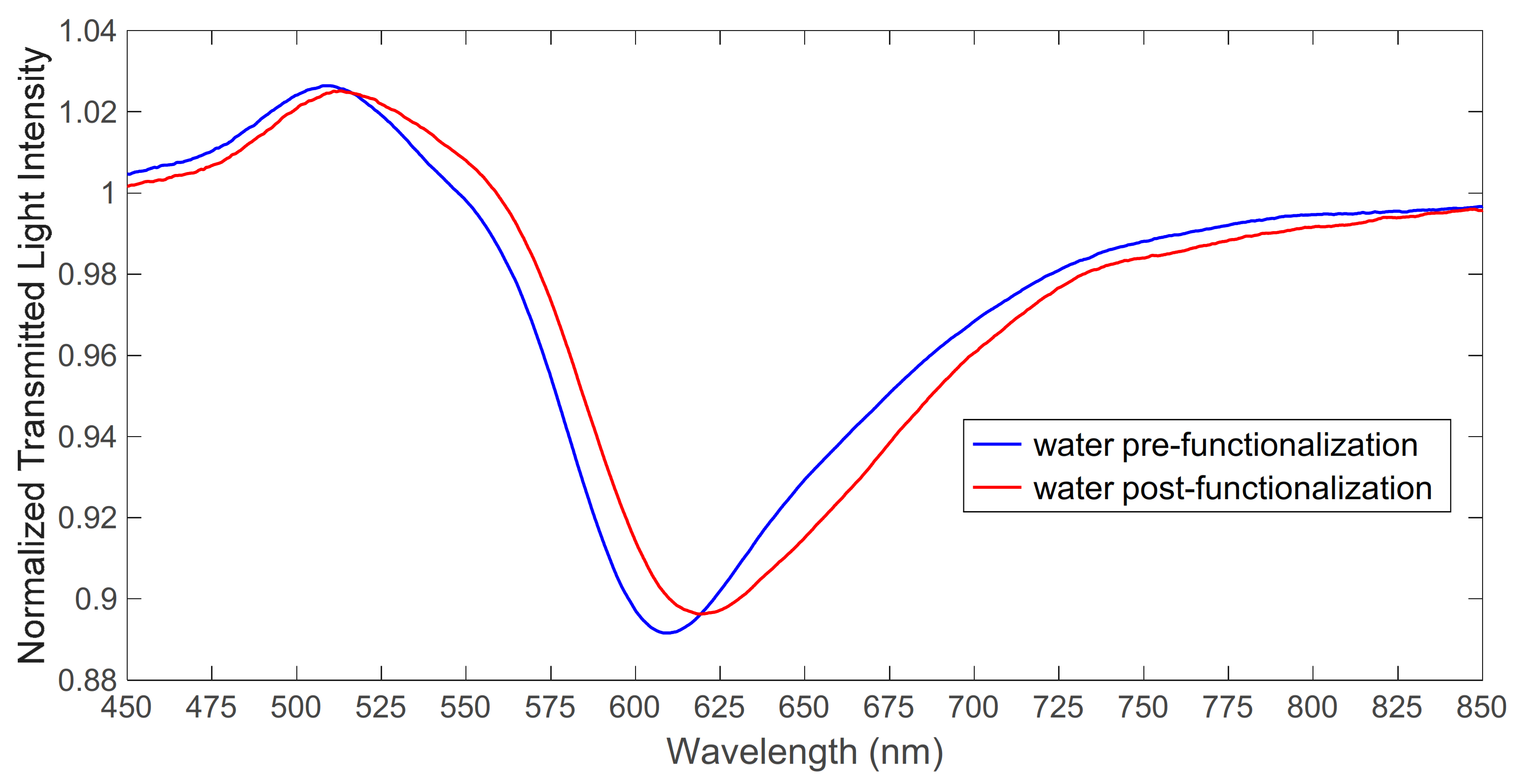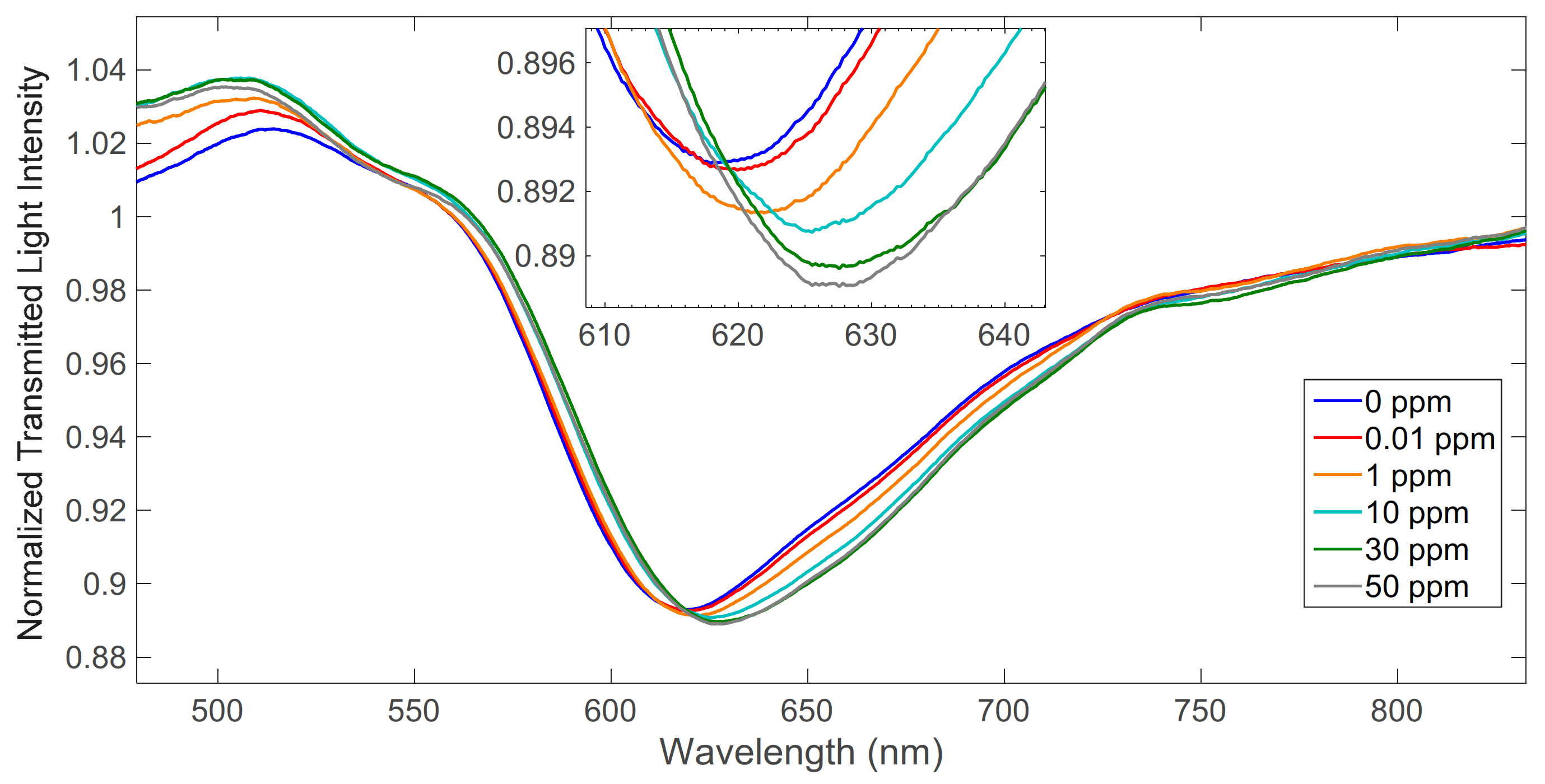An Optical Fiber Sensor System for Uranium Detection in Water †
Abstract
:1. Introduction
2. Materials and Methods
2.1. Reagents
2.2. Instruments and Experimental Setup
2.3. SPR-POF Platforms Preparation
2.4. MUPA Deposition
2.5. Measurements
3. Results
4. Conclusions
Author Contributions
Funding
Institutional Review Board Statement
Informed Consent Statement
Data Availability Statement
Conflicts of Interest
References
- Alberti, G.; Biesuz, R.; Pesavento, M. Determination of the total concentration and speciation of Uranium in natural waters by the Resin Titration method. Microchem. J. 2007, 86, 166–173. [Google Scholar] [CrossRef]
- Danesi, P.R.; Bleise, A.; Burkart, W.; Cabianca, T. Isotopic composition and origin of uranium and plutonium in selected soil samples collected in Kosovo. J. Environ. Radioact. 2003, 64, 121–131. [Google Scholar] [CrossRef]
- Saleh, I.H.; Abdel-Halim, A.A. Determination of depleted uranium using a high-resolution gamma-ray spectrometer and its applications in soil and sediments. J. Taibah Univ. Sci. 2016, 10, 205–211. [Google Scholar] [CrossRef]
- Cennamo, N.; Massarotti, D.; Conte, L.; Zeni, L. Low Cost Sensors Based on SPR in a Plastic Optical Fiber for Biosensor Implementation. Sensors 2011, 11, 11752–11760. [Google Scholar] [CrossRef] [PubMed]
- Cennamo, N.; Pesavento, M.; Zeni, L. A review on simple and highly sensitive plastic optical fiber probes for bio-chemical sensing. Sens. Actuators B Chem. 2021, 331, 129393. [Google Scholar] [CrossRef]
- Pesavento, M.; Profumo, A.; Merli, D.; Cucca, L.; Zeni, L.; Cennamo, N. An Optical Fiber Chemical Sensor for the Detection of Copper(II) in Drinking Water. Sensors 2019, 19, 5246. [Google Scholar] [CrossRef] [PubMed] [Green Version]
- Cennamo, N.; Alberti, G.; Pesavento, M.; D’Agostino, G.; Quattrini, F.; Biesuz, R.; Zeni, L. A Simple Small Size and Low Cost Sensor Based on Surface Plasmon Resonance for Selective Detection of Fe(III). Sensors 2014, 14, 4657–4661. [Google Scholar] [CrossRef] [PubMed]
- Merli, D.; Protti, S.; Labò, M.; Pesavento, M.; Profumo, A. A ω-mercaptoundecylphosphonic acid chemically modied gold electrode for uranium determination in waters in presence of organic matter. Talanta 2016, 151, 119–125. [Google Scholar] [CrossRef] [PubMed]
- Garcia-Calzon, J.A.; Diaz-Garcia, M.E. Characterization of binding sites in molecularly imprinted polymers. Sens. Actuators B Chem. 2007, 123, 1180–1194. [Google Scholar] [CrossRef]



Publisher’s Note: MDPI stays neutral with regard to jurisdictional claims in published maps and institutional affiliations. |
© 2022 by the authors. Licensee MDPI, Basel, Switzerland. This article is an open access article distributed under the terms and conditions of the Creative Commons Attribution (CC BY) license (https://creativecommons.org/licenses/by/4.0/).
Share and Cite
Cennamo, N.; Pesavento, M.; Merli, D.; Profumo, A.; Zeni, L.; Alberti, G. An Optical Fiber Sensor System for Uranium Detection in Water. Eng. Proc. 2022, 16, 10. https://doi.org/10.3390/IECB2022-12296
Cennamo N, Pesavento M, Merli D, Profumo A, Zeni L, Alberti G. An Optical Fiber Sensor System for Uranium Detection in Water. Engineering Proceedings. 2022; 16(1):10. https://doi.org/10.3390/IECB2022-12296
Chicago/Turabian StyleCennamo, Nunzio, Maria Pesavento, Daniele Merli, Antonella Profumo, Luigi Zeni, and Giancarla Alberti. 2022. "An Optical Fiber Sensor System for Uranium Detection in Water" Engineering Proceedings 16, no. 1: 10. https://doi.org/10.3390/IECB2022-12296
APA StyleCennamo, N., Pesavento, M., Merli, D., Profumo, A., Zeni, L., & Alberti, G. (2022). An Optical Fiber Sensor System for Uranium Detection in Water. Engineering Proceedings, 16(1), 10. https://doi.org/10.3390/IECB2022-12296










